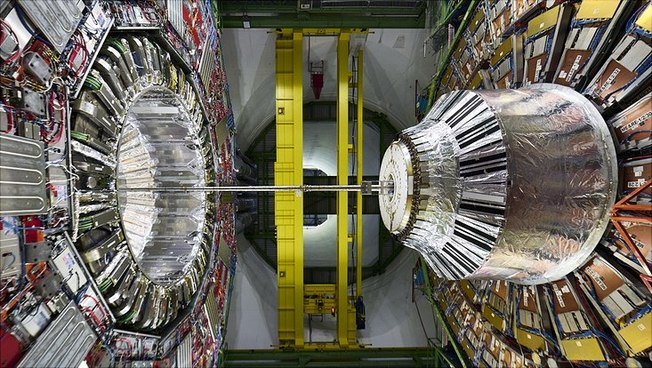10 June 2024
Funding from the Federal Ministry of Education and Research€4.8 million for Projects on the Big Bang and the Higgs Particle

Photo: Cern/Hertzog/Ordan
The scientists from Universität Hamburg’s Institute of Experimental Physics (IEP) have been involved for 20 years in the Compact Muon Solenoid Experiment, or CMS for short—a detector that is part of the world's most powerful particle accelerator, the Large Hadron Collider at the European Research Centre CERN in Switzerland. This major international project focuses on the smallest building blocks of matter, the so-called elementary particles, such as the Higgs particle.
Current research projects are focussing on a possible connection between the Higgs particle and the processes of the Big Bang as well as on the identification of previously unknown particles of dark matter, which makes up a large part of the matter in the universe. The researchers at Universität Hamburg will receive a total of €4.8 million from the Federal Ministry of Education and Research for this work over the next 3 years. The funding is part of the framework program Exploring the Universe and Matter. The working groups of Prof. Dr. Erika Garutti, Prof. Dr. Peter Schleper, Prof. Dr. Johannes Haller, Prof. Dr. Konstantinos Nikolopoulos, and Prof. Dr. Gregor Kasieczka, who are all part of the Cluster of Excellence Quantum Universe, are involved.
Some of the funds will be used to operate the detector, jobs will also be created, and young scientists in particular will receive support. “This will ensure that we can analyse the recorded data in Hamburg. In addition to personnel, this also requires large computer farms due to the enormous amounts of data,” says Dr. Matthias Schröder, scientist at the IEP and expert in the field of Higgs physics. Dr. Hartmut Stadie, the scientist responsible for computing at the IEP, adds that the approved funding will facilitate the infrastructure set-up for this purpose in Hamburg to be operated effectively over the next 3 years.
At the same time, the Hamburg groups are also looking to the future: together with colleagues from the Karlsruhe Institute of Technology, the Rheinisch-Westfälische Technische Hochschule Aachen, and the Hamburg Helmholtz Centre DESY, they will prepare the CMS detector for the period from 2029.
In 5 years, the performance of the entire accelerator complex is to be significantly increased once again, which will change the requirements for the detector. “In Hamburg, we have been preparing for this conversion for years and have developed new detector concepts that can withstand the new conditions. We now have the necessary resources to build these detectors,” says Dr. Georg Steinbrück, head scientist in the Detector Development Department at the IEP.
